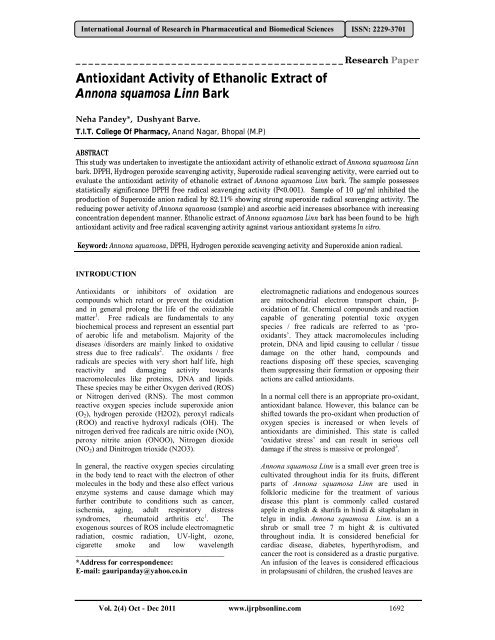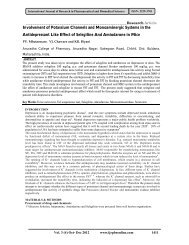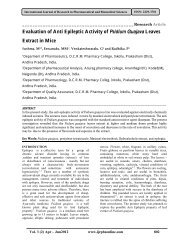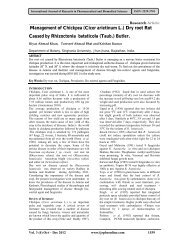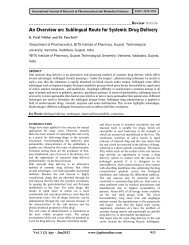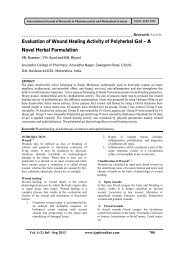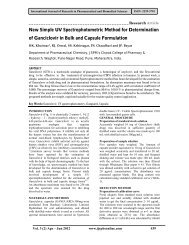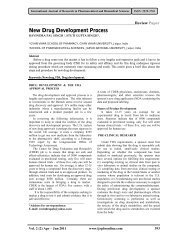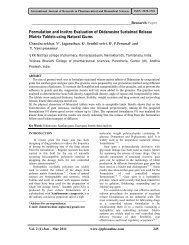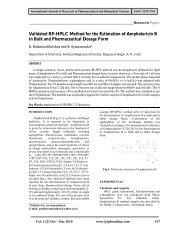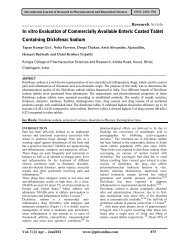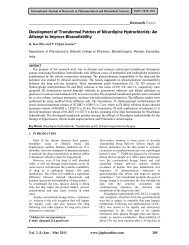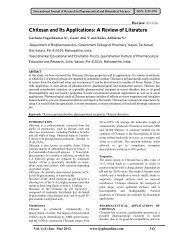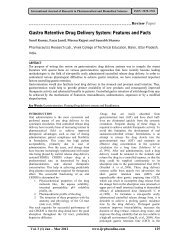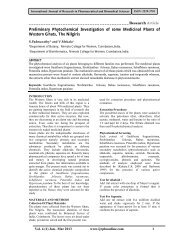Antioxidant Activity of Ethanolic Extract of Annona squamosa Linn Bark
Antioxidant Activity of Ethanolic Extract of Annona squamosa Linn Bark
Antioxidant Activity of Ethanolic Extract of Annona squamosa Linn Bark
You also want an ePaper? Increase the reach of your titles
YUMPU automatically turns print PDFs into web optimized ePapers that Google loves.
International Journal <strong>of</strong> Research in Pharmaceutical and Biomedical Sciences ISSN: 2229-3701<br />
__________________________________________Research Paper<br />
<strong>Antioxidant</strong> <strong>Activity</strong> <strong>of</strong> <strong>Ethanolic</strong> <strong>Extract</strong> <strong>of</strong><br />
<strong>Annona</strong> <strong>squamosa</strong> <strong>Linn</strong> <strong>Bark</strong><br />
Neha Pandey*, Dushyant Barve.<br />
T.I.T. College Of Pharmacy, Anand Nagar, Bhopal (M.P)<br />
ABSTRACT<br />
This study was undertaken to investigate the antioxidant activity <strong>of</strong> ethanolic extract <strong>of</strong> <strong>Annona</strong> <strong>squamosa</strong> <strong>Linn</strong><br />
bark. DPPH, Hydrogen peroxide scavenging activity, Superoxide radical scavenging activity, were carried out to<br />
evaluate the antioxidant activity <strong>of</strong> ethanolic extract <strong>of</strong> <strong>Annona</strong> <strong>squamosa</strong> <strong>Linn</strong> bark. The sample possesses<br />
statistically significance DPPH free radical scavenging activity (P
International Journal <strong>of</strong> Research in Pharmaceutical and Biomedical Sciences ISSN: 2229-3701<br />
sniffed to over come hysteria & fainting spells,they<br />
are also applied on ulcer & wounds. The ripe fruits<br />
<strong>of</strong> this plants are applied to malignant tumors to<br />
hasten suppuration. The dried unripe fruit powder<br />
is used to destroy vermin. The seeds are acrid and<br />
poisoinous. Powdered seeds serve as fish poison<br />
and inseticides. A paste <strong>of</strong> seed powder has been<br />
applied to the head to kill lice.It is also used for<br />
destroying worm in the wound <strong>of</strong> cattles 4 . The<br />
fruits pulp contain 27 percent sugar and 0.3 percent<br />
acids. The bark contains 2.02 percent <strong>of</strong> tannins . It<br />
also contain β-sitosterol borneol and camohor 5 .<br />
MATERIAL & METHOD<br />
Plant material and extraction procedures:<br />
The plant material A.<strong>squamosa</strong> <strong>Linn</strong> bark was<br />
collected in the month <strong>of</strong> November – December,<br />
2010 from the Gour hills, Sagar (M.P). The plant<br />
has been identified and authenticated by Dr. Zea Ul<br />
Hasan Head <strong>of</strong> the Department Botany, at the Safia<br />
college <strong>of</strong> science, Bhopal (M.P). The plant parts<br />
specimen were submitted as herbarium with<br />
voucher specimen no 232/ Bot/ Safia/11. The drug<br />
was dried initially under shade. It was preserved in<br />
air tight containers. The completely dried material<br />
<strong>of</strong> <strong>Annona</strong> <strong>squamosa</strong> <strong>Linn</strong> bark was coarsely<br />
powdered. The dried bark powder <strong>of</strong> <strong>Annona</strong><br />
<strong>squamosa</strong> <strong>Linn</strong> was extracted with 90% ethanol<br />
by maceration for 7 days with occasional shaking.<br />
The extract was filtered and concentrated under<br />
reduced pressure and at lower temperature using<br />
rotary evaporator and dried. The ethanolic extract<br />
was subjected to qualitative phytochemical analysis<br />
for presence <strong>of</strong> various constituents like Alkaloids,<br />
Carbohydrates, Glycosides, Proteins and Amino<br />
acids, Phenolic compounds, Tannins, Oils and<br />
fats, Saponins.<br />
Experimental / method<br />
Determination <strong>of</strong> Total phenolic content:<br />
The total phenolic concentration was measured<br />
using the Folin-Ciocalteu method. In this<br />
procedure, 1 ml <strong>of</strong> approx. diluted samples and a<br />
standard solution <strong>of</strong> gallic acid were added to a 25<br />
ml volumetric flask containing 9 ml <strong>of</strong> doubled<br />
distilled water .A reagent blank using double<br />
distilled water was prepared. 0.5 ml <strong>of</strong> sample<br />
(1mg/ml) solution was mixed with 2.5 ml <strong>of</strong> Folin<br />
ciocalteu phenolic reagent (10 %) and 2 ml <strong>of</strong> 7.5<br />
% Na 2 CO 3 solution and mixed. After that reacting<br />
mixture was incubated for 30 min at room<br />
temperature in dark condition and measured the<br />
absorbance at 760 nm 6 .<br />
DPPH radical scavenging activity:<br />
For assessment <strong>of</strong> DPPH radical scavenging<br />
activity DPPH solution was prepared by dissolving<br />
4 mg DPPH in 100 ml methanol. A dilution series<br />
were prepared for ascorbic acid and extract. After<br />
that 5ml <strong>of</strong> sample solution was mixed with 0.5 ml<br />
DPPH solution and incubated for 30 min at room<br />
temperature in dark condition and absorbance was<br />
taken at 517 nm and calculated the % inhibition <strong>of</strong><br />
DPPH radical 7 .<br />
Hydroxyl radical scavenging activity<br />
The ability <strong>of</strong> extracts to scavenge hydrogen<br />
peroxide was determined by little modification here<br />
the solution <strong>of</strong> hydrogen peroxide (100mM) was<br />
prepared instead <strong>of</strong> 40mM in phosphate buffer<br />
saline <strong>of</strong> (PH 7.4), at various concentration <strong>of</strong><br />
ethanolic extract (100 -1000 μg/ml) were added to<br />
hydrogen peroxide solution (2 ml). Absorbance <strong>of</strong><br />
hydrogen peroxide at 230 nm was determined after<br />
10 minutes against a blank solution containing<br />
phosphate buffer without hydrogen peroxide. For<br />
each concentration, a separate blank sample was<br />
used for back ground subtraction. In case <strong>of</strong> control<br />
takes absorbance <strong>of</strong> hydrogen peroxide at 230 nm<br />
without sample extracts. The percentage inhibition<br />
activity was calculated from,<br />
% inhibition = [(A0-A1)/A0] x 100<br />
where A0 is the absorbance <strong>of</strong> the control and A1<br />
is the absorbance <strong>of</strong> extract/standard taken as<br />
Gallic acid (10 -100 μg/ml) 8 .<br />
Superoxide radical scavenging activity:<br />
This activity was measured using NBT (Nitro blue<br />
tetrazolium reagent). The method is based on<br />
generation <strong>of</strong> superoxide radical (O 2 - ) by auto<br />
oxidation <strong>of</strong> hydroxylamine hydrochloride in<br />
presence <strong>of</strong> NBT, which gets reduced to nitrite.<br />
Nitrite in presence <strong>of</strong> EDTA gives a color that can<br />
be measured at 560 nm. Various concentrations (1,<br />
2, 4, 6, 8, 10µg/ml) <strong>of</strong> test solutions were taken in<br />
test tube. To this, reaction mixture consisting <strong>of</strong> 1<br />
ml <strong>of</strong> 50 mM sodium carbonate, 0.4 ml <strong>of</strong> 24 mM<br />
NBT 0.2 ml <strong>of</strong> 0.1 mM EDTA solution were added<br />
to the test tube and zero minute reading was taken<br />
at 560 nm. The reaction was initiated by the<br />
addition <strong>of</strong> 0.4 ml <strong>of</strong> 1 mM hydroxylamine<br />
hydrochloride to the above solution. Reaction<br />
mixture was incubated at 25 0 C for 15 minute; the<br />
reduction <strong>of</strong> NBT was measured at 560 nm.<br />
Absorbance was recorded and % inhibition was<br />
calculated according to the following equation.<br />
% inhibition = [(Ao-At) / Ao x 100]<br />
Where Ao was the absorbance <strong>of</strong> the control<br />
(blank, without extract) and At was the absorbance<br />
in the presence <strong>of</strong> the extract 8 .<br />
Vol. 2(4) Oct - Dec 2011 www.ijrpbsonline.com 1693
International Journal <strong>of</strong> Research in Pharmaceutical and Biomedical Sciences ISSN: 2229-3701<br />
STATICAL ANALYSIS<br />
All the values are expresses as mean ± SD and data<br />
was analyzed by One-way ANOVA, using<br />
Graphpad INSTAT. The post-hock analysis was<br />
carried out by Dunnet’s multiple comparison tests<br />
to estimate the significance <strong>of</strong> difference between<br />
individual groups (P
International Journal <strong>of</strong> Research in Pharmaceutical and Biomedical Sciences ISSN: 2229-3701<br />
Table 2. Effect <strong>of</strong> <strong>Ethanolic</strong> extract <strong>of</strong> <strong>Annona</strong> <strong>squamosa</strong> <strong>Linn</strong> in DPPH <strong>Antioxidant</strong> model<br />
S.No. Conc.µg/ml<br />
% Inhibition<br />
Sample<br />
Ascorbic acid<br />
1. 1 8.64 12.56<br />
2. 2 14.34 19.87<br />
3. 4 22.55 27.56<br />
4. 6 26.98 32.01<br />
5. 8 29.87 36.89<br />
6. 10 34.76 47.93<br />
Table 3. Effect <strong>of</strong> <strong>Ethanolic</strong> extract <strong>of</strong> <strong>Annona</strong> <strong>squamosa</strong> <strong>Linn</strong> in Hydroxyl radical scavenging activity<br />
S.No. Conc.µg/ml<br />
% Inhibition<br />
Sample<br />
Ascorbic acid<br />
1. 1 1.12 3.82<br />
2. 2 2.65 5.43<br />
3. 4 4.78 6.62<br />
4. 6 5.52 7.32<br />
5. 8 6.22 8.42<br />
6. 10 8.38 10.11<br />
Table 4. Effect <strong>of</strong> <strong>Ethanolic</strong> extract <strong>of</strong> <strong>Annona</strong> <strong>squamosa</strong> <strong>Linn</strong> in Superoxide radical scavenging activity<br />
S.No. Conc.µg/ml<br />
% Inhibition<br />
Sample<br />
Ascorbic acid<br />
1. 1 12.31 32.78<br />
2. 2 28.67 49.11<br />
3. 4 43.38 58.74<br />
4. 6 61.09 79.21<br />
5. 8 73.54 83.07<br />
6. 10 82.11 90.34<br />
Graph: 1 Gallic acid standard curve<br />
Vol. 2(4) Oct - Dec 2011 www.ijrpbsonline.com 1695
International Journal <strong>of</strong> Research in Pharmaceutical and Biomedical Sciences ISSN: 2229-3701<br />
Graph: 2. Comparative effect <strong>of</strong> <strong>Ethanolic</strong> extract <strong>of</strong> <strong>Annona</strong> <strong>squamosa</strong> <strong>Linn</strong> (sample) and Ascorbic acid<br />
on DPPH assay<br />
Graph: 3. Comparative effect <strong>of</strong> <strong>Ethanolic</strong> extract <strong>of</strong> <strong>Annona</strong> <strong>squamosa</strong> <strong>Linn</strong> (sample) and Ascorbic acid<br />
on Superoxide radical scavenging activity<br />
Graph: 4. Comparative effect <strong>of</strong> <strong>Ethanolic</strong> extract <strong>of</strong> <strong>Annona</strong> <strong>squamosa</strong> <strong>Linn</strong> (sample) and Ascorbic acid<br />
on Hydroxyl radical scavenging activity<br />
Vol. 2(4) Oct - Dec 2011 www.ijrpbsonline.com 1696
International Journal <strong>of</strong> Research in Pharmaceutical and Biomedical Sciences ISSN: 2229-3701<br />
REFERENCES<br />
1. Kokate C.K., Purohit A.P., Gokhale S.B. “Text<br />
book <strong>of</strong> pharmacognosy”, 2004, 29, pp. 317-<br />
318, 336-337, 542.<br />
2. Velavan S., Nagulendran K., Mahesh R.,<br />
“Invitro antioxidant activity <strong>of</strong> Asparagus<br />
3. racemosus root”, Pharmacog Mag., Jan.-March<br />
2007, 3, pp.26-33.<br />
4. Gupta S., Shukla R., Sharma K.K.,<br />
“Antidiabetic, Antihypercholesterolemic and<br />
5. antioxidant effect <strong>of</strong> Ocimum sanctum <strong>Linn</strong>.<br />
Seed oil”, Ind. Jr. Exp. Biol., Apr. 2006, 44(4),<br />
pp.300-303.<br />
6. 4. Sahai Mahendra & Ranjan Rakesh.,<br />
“Coumarinolignans from the seeds <strong>of</strong> Annano<br />
Squmosa linn”, E- journal <strong>of</strong> chemistry., 2009,<br />
6(2), pp. 518-522.<br />
7. 5. Suresh K; Mamoharan S; Panjamurthy K.,<br />
Kavitha .K., “Chemopreventive and<br />
antilipidperoxidative efficiency <strong>of</strong> <strong>Annona</strong><br />
<strong>squamosa</strong> bark extract”, Pakistan journal <strong>of</strong><br />
Biological sciences; 2006, 9(14); pp.2600-<br />
2605.<br />
8. 6. Koleva, I.I., T.A. Van Beek, J.P. H.Linssen,<br />
A. De Groot and L.N. Evstatieva, “Screening <strong>of</strong><br />
plant extracts for antioxidant activity: a<br />
comparative study on three testing methods.<br />
Phytochemical Analysis”, 13; pp. 8-17.<br />
9. 7. Mcdonald S, Prenzler PD, Autolovich M,<br />
Robards K. “Phenolic content and antioxidant<br />
activity <strong>of</strong> olive oil extracts.” Food Chem ; 2001<br />
,73; pp73–84.<br />
10. 8. Singh Narinder, Saini .B.S., Singh Ramnik ,<br />
Rao Singh Harwinder, “In-vitro antioxidant<br />
activity <strong>of</strong> pet ether extract <strong>of</strong> black pepper” .<br />
Indian J Pharmacol ., 2008, 40(4); pp 147-151.<br />
11. 9. Mishra R.N., Jain Neha. “ <strong>Antioxidant</strong><br />
activity <strong>of</strong> Trikatu mega extract “ .<br />
Internatnational Journal <strong>of</strong> Research in<br />
Pharmaceutical and Biomedical Sciences”.<br />
2011, 2(2); pp 624-628.<br />
12. 10. Rathore K.S , Panchawat S. , Sisodia.S.S ,<br />
“A review on herbal <strong>Antioxidant</strong>s”.<br />
International journal <strong>of</strong> PharmTech Research,<br />
2010 2(1); pp 232-239.<br />
13. 11. Krishnamurthy A., “The wealth <strong>of</strong> India”,<br />
Vol VIII, publication and information<br />
directorate, CSIR, New Delhi, 1969, pp.294-<br />
295.<br />
Vol. 2(4) Oct - Dec 2011 www.ijrpbsonline.com 1697


